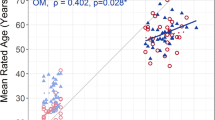Abstract
The phonetic gender score is a new quantitative scale that was applied to the spoken sounds of first names. Popular names of females have predominantly positive scores, and popular names of males have predominantly negative scores. Mean phonetic gender scores were higher in 1990 than in 1960 for the 25 most frequent names given to females and males born in Pennsylvania. Choices of names were more diverse for females than males in both years and in 1990 than 1960 for both genders. The increased choice in 1990 of attributes associated with females may indicate greater acceptance of female characteristics in 1990 than in 1960. In 1990 the most numerous racial minority, African Americans, constituted 15% of the births but only 5% of the females and 7% of the males given the 25 most frequent names.
Similar content being viewed by others
References
Adams, C. H., & Sherer, M. (1985). Sex-role orientation and psychological adjustment: implications for the masculinity model.Sex Roles, 12, 1211–1218.
Barry, H., III, Bacon, M. K. & Child, I. L. (1957). A cross-cultural survey of some sex differences in socialization.Journal of Abnormal and Social Psychology, 55, 327–332.
Barry, H., III, & Harper, A. S. (1982). Evolution of unisex names.Names, 30, 15–22.
Barry, H., III, & Harper, A. S. (1993a). Sex differences in linguistic origins of personal names. In E. W. McMullen (Ed.),Names new and old. Madison, NJ: Penny Press.
Barry, H., III, & Harper, A. S. (1993b). Feminization of unisex names from 1960 to 1990.Names, 41, 228–238.
Bem, S. L. (1993).The lenses of gender. New Haven, CT: Yale University Press.
Bergen, D. J., & Williams, J. E. (1991). Sex stereotypes in the United States revisited: 1972–1988.Sex Roles, 24, 413–423.
Brooks-Gunn, J., & Fisch, M. (1980). Psychological androgyny and college students' judgments of mental health.Sex Roles, 6, 575–580.
Duffy, J. C., & Ridinger, B. (1981). Stereotyped connotations of masculine and feminine names.Sex Roles, 7, 25–33.
Etaugh, C., & Liss, M. B. (1992). Home, school, and playroom: training grounds for adult gender roles.Sex Roles, 26, 129–147.
Garwood, S. G., Baer, S., Levine, D., Carroll, S., & O'Neal, E. (1981). Sex-role expectations of socially desirable first names.Sex Roles, 7, 257–262.
Hawkins, P. (1984).Introducing phonology. London: Hutchinson.
Hort, B. E., Fagot, B. I., & Leinbach, M. D. (1990). Are people's notions of maleness more stereotypically framed than their notions of femaleness?Sex Roles, 23, 197–212.
Lieberson, S., & Bell, E. O. (1992). Children's first names: an empirical study of social taste.American Journal of Sociology, 98, 511–554.
Martin, C. L. (1990). Attitudes and expectations about children with nontraditional and traditional gender roles.Sex Roles, 22, 151–165.
Pennsylvania Statistical Abstract (1961). (14th ed.). Harrisburg: Pennsylvania Bureau of Publications.
Pennsylvania Vital Statistics Annual Report, 1990. Harrisburg: Pennsylvania State Health Data Center.
Rossi, A. S. (1965). Naming children in middle-class families.American Sociological Review, 30, 499–513.
Schwegel, J. (1988).The Baby Name Countdown: Popularity and Meaning of Today's Baby Names. Edmonton, Alberta, Canada: Personal Publishing.
Slater, A. S., & Feinman, S. (1985). Gender and the phonology of North American first names.Sex Roles, 13, 429–440.
Smith, E. C. (1950).The story of our names. New York: Harper.
SPSS Inc. (1986).SPSSX User's Guide (2nd ed.). Chicago: SPSS.
Werner, P. D., & LaRussa, G. W. (1985). Persistence and change in sex-role stereotypes.Sex Roles, 12, 1089–1100.
Whitley, B. E., Jr. (1984). Sex-role orientation and psychological well-being: two meta-analyses.Sex Roles, 12, 207–225.
Author information
Authors and Affiliations
Additional information
The data on frequencies of first names were supplied by the State Center for Health Statistics and Research, Pennsylvania Department of Health, Harrisburg, Pennsylvania. The Department specifically disclaims responsibility for any analyses, interpretations, or conclusions.
Helpful services were received from the Pennsylvania State Center for Health Statistics and Research, in particular by Jerry Orris, and from the University of Pittsburgh Computer Center, in particular data transfer and programming by Eileen S. Kopchik and statistical consultation by Clement A. Stone.
A portion of this study was reported at the 33rd Names Institute, Baruch College, New York, on May 7, 1994.
Community College of Allegheny County
Rights and permissions
About this article
Cite this article
Barry, H., Harper, A.S. Increased choice of female phonetic attributes in first names. Sex Roles 32, 809–819 (1995). https://doi.org/10.1007/BF01560190
Issue Date:
DOI: https://doi.org/10.1007/BF01560190




